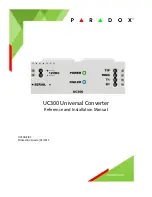
VDA51
Dolby® Virtual Speaker Surround Processor
Digital-to-Analog Converter
INSTALLATION INSTRUCTIONS
DESCRIPTION
The Xantech VDA51 Dolby® Virtual Speaker Surround Processor/Digital-to-Analog Converter is designed
to decode PCM or DOLBY DIGITAL encoded digital audio, and to output it as left and right analog line level
audio. Thanks to its built in Dolby Virtual Speaker surround processing capability, the VDA51 is also able to
decode any surround information that may be present in this digital audio signal. The result is lifelike
surround audio experience from a pair of stereo speakers.
INSTALLATION
The VDA51 can be placed at coaxial digital output of a source unit, and its analog audio output can be
routed to an analog pre-amp/amplifier, or to line level analog audio inputs of a multiroom system such
as the Xantech MRC88m.
The VDA51 can also be connected to the SPDIF output of a Xantech HDRXSG01 HD video single gang
receiver box to provide analog audio a any zone of a multiroom system comprised of HD88C or HD44C
HD Component Video Switcher.
Make connections in the following order (numbered callouts correspond to the figures below):
o
Connect coaxial digital out from an audio or AV source with coaxial digital out, or from Xantech
HDRXSG01, to VDA51 SPDIF IN (1), using a single male-to-male RCA patch cord.
o
Connect Left and Right RCA output from VDA51 (2) to a Pre-amp/Amplifier or a multiroom
system controller’s line level input, using a dual male-to-male RCA patch cord.
o
Select WIDE or REF (these are Dolby Virtual Speaker settings), or OFF (no virtualization), using
the VIRTUAL slide switch (3) on VDA51. Each setting will provide a different level of surround
information and listener experience. Please note that the amount of surround effect heard can be
dependent on the amount and type of encoding that is used during the recording process and
may not be obvious with every listening material. Some empirical listening and experimentation
will be necessary in choosing the desired setting.




















